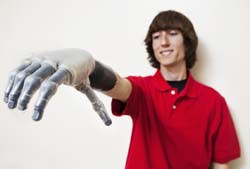Optimising myoelectric prostheses
Myoelectric prostheses use electrical signals from muscles to control artificial limb movement. Most commercial myoelectric control systems used in prostheses can reliably control only one degree of freedom (DOF) at a time, limiting user acceptance and performance. Scientists from the EU-supported AMYO (Advanced myoelectric control of prosthetic systems) project with expertise in multidisciplinary fields worked on improving signal acquisition, signal processing and pattern recognition to reliably control multiple DOFs. Their ultimate goal was to ensure commercial viability. During the first half of the project, the team analysed the current state of the art in myoelectric control of prostheses. Lack of robustness was identified as a major hurdle to commercial application. Building on this result, researchers developed electromyogram electrodes tailored to the residual limbs of amputees to ensure better signal acquisition. Scientists also developed advanced signal processing methods using neurophysiological modelling and machine learning principles to obtain intuitive, proportional and simultaneous control of two DOFs. The system was tested on both intact and residual limbs, demonstrating an important increase in performance compared to current myoelectric prostheses. However, test results also highlighted the need for further improved reliability. To effectively train users, AMYO devised a novel training system based on performance and psychometric measures. Project outcomes were disseminated via seven scientific publications. AMYO has considerably increased the reliability and robustness of the myoelectric control system with two DOFs. Further improvements and rapid commercialisation should provide relief for millions of prosthetics users. A major bonus is that AMYO technology could also be adapted to other assistive devices requiring man-machine interfaces such as orthotics and neurorehabilitation devices.







